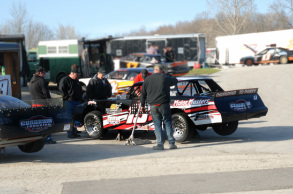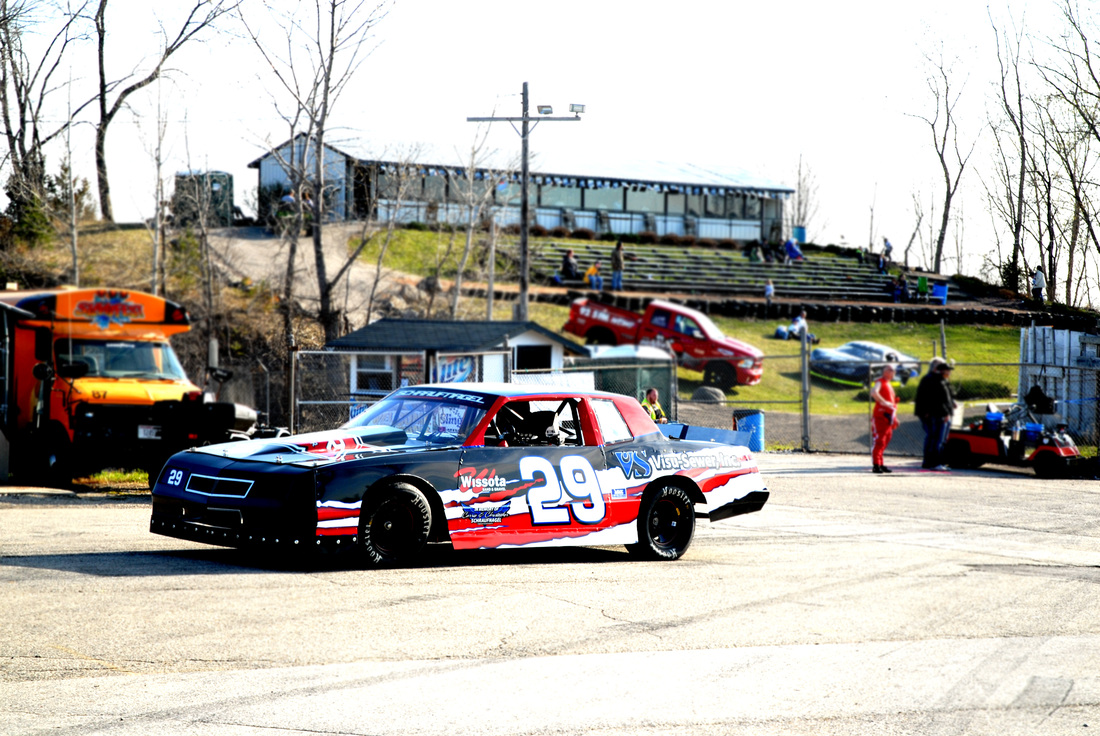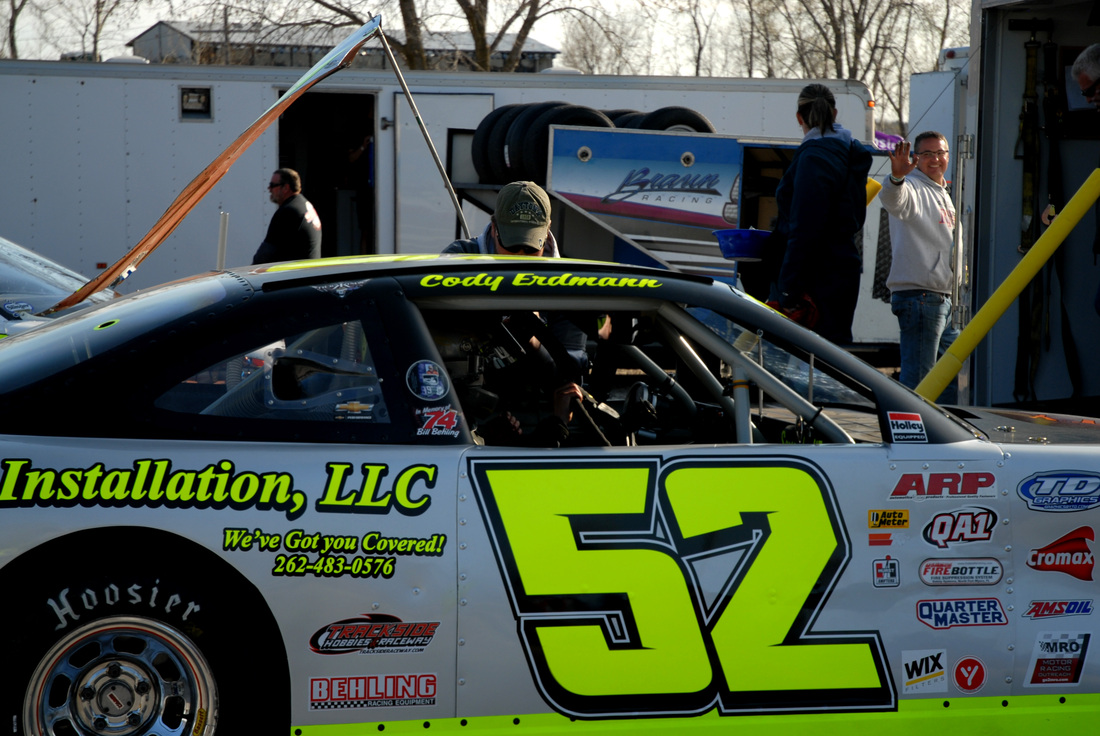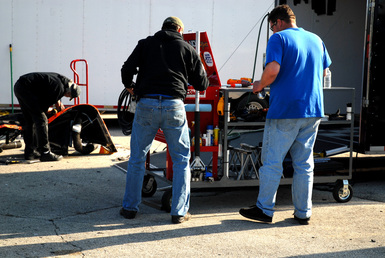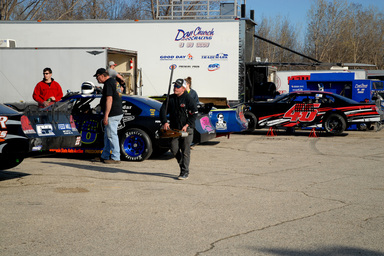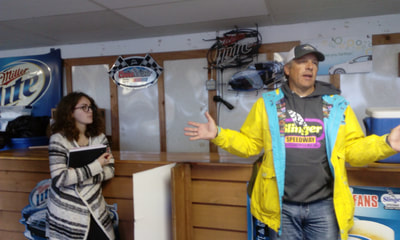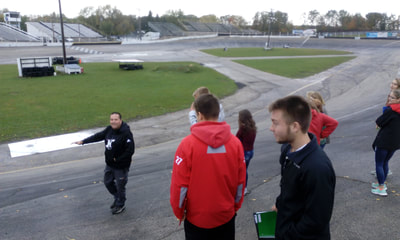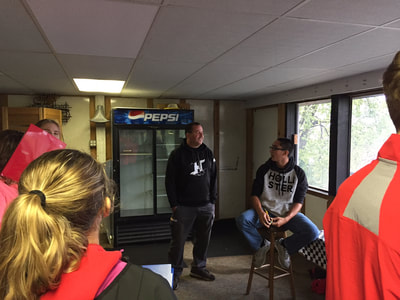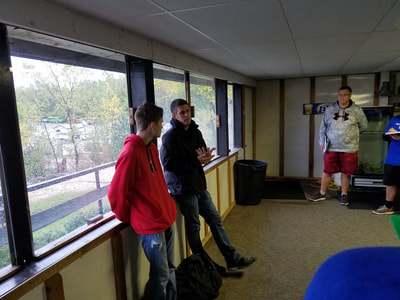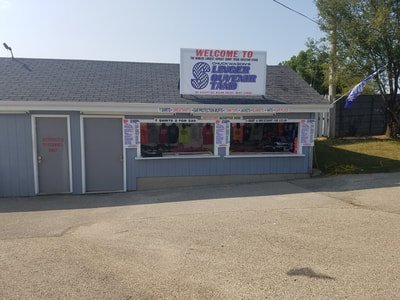Photo above taken by student, Amber Zawistowski
Racing Culture in the Slinger Area
Introduction: Sociology and history students in 2013-2014 at Slinger High School decided to study the various aspects of the racing culture in the Slinger area with the hopes of making conclusions about the racing culture locally as well as to try to preserve some of the memories from the Slinger Super Speedway. Future research will be added and the year of additional data will be documented.
Research Design: To determine the layers of the racing culture in the Slinger Area and the memories at the race track in Slinger, the research was collected in multiple ways. History class students analyzed several secondary sources including the Slinger Historical Album: 150 Years, Milwaukee Journal Sentinel, the West Bend Daily News, the Slinger Super Speedway website, and the Fr. Dale Grubba book, The Milwaukee Modified Era: 1950-1973. In addition, they interviewed several community members who they knew with strong ties to racing to gather their favorite memories of the Slinger Super Speedway in 2013-2014 school year. Students who raced at the Slinger Super Speedway in 2013 season interviewed several notable racing community members and some sociology/history students interviewed some families who are involved in racing to gain perspective.
Sociology class students created a digital survey for racers, racing crew, and Slinger Super Speedway fans in October 2013. Digital surveys were passed along primarily via word of mouth, social networking, and by using e-mail addresses from Slinger Speedway e-mail listings.
The majority of the data was collected from October 2013 to April 2014. Select pieces of data were added in the 2017-2018 school year.
DATA: The data is organized into categories. Racer, Race Crew, and Community. Within Community, you'll see a special emphasis on Racing Families, Memorial Go-Kart, Inc, and more.
Introduction: Sociology and history students in 2013-2014 at Slinger High School decided to study the various aspects of the racing culture in the Slinger area with the hopes of making conclusions about the racing culture locally as well as to try to preserve some of the memories from the Slinger Super Speedway. Future research will be added and the year of additional data will be documented.
Research Design: To determine the layers of the racing culture in the Slinger Area and the memories at the race track in Slinger, the research was collected in multiple ways. History class students analyzed several secondary sources including the Slinger Historical Album: 150 Years, Milwaukee Journal Sentinel, the West Bend Daily News, the Slinger Super Speedway website, and the Fr. Dale Grubba book, The Milwaukee Modified Era: 1950-1973. In addition, they interviewed several community members who they knew with strong ties to racing to gather their favorite memories of the Slinger Super Speedway in 2013-2014 school year. Students who raced at the Slinger Super Speedway in 2013 season interviewed several notable racing community members and some sociology/history students interviewed some families who are involved in racing to gain perspective.
Sociology class students created a digital survey for racers, racing crew, and Slinger Super Speedway fans in October 2013. Digital surveys were passed along primarily via word of mouth, social networking, and by using e-mail addresses from Slinger Speedway e-mail listings.
The majority of the data was collected from October 2013 to April 2014. Select pieces of data were added in the 2017-2018 school year.
DATA: The data is organized into categories. Racer, Race Crew, and Community. Within Community, you'll see a special emphasis on Racing Families, Memorial Go-Kart, Inc, and more.
_____________________________________________________
Racer
Racer
Photos above taken by student, Amber Zawistowski
Results from survey of over 70 racers conducted via e-mail between Oct. 2013-Jan. 2014
Click here for Age of respondents
Click here for Why Respondents got involved in racing
Click here for Hours spent with Racing Crew
Click here for Favorite Race Track
Click here for Years Racing at Slinger Super Speedway
Click here for Why Racers Race at Slinger
Click here for Favorite Slinger Race (2013)
Click here for how Racers interact with Community
Click here for what businesses racers frequent
Click here for favorite Slinger Race Track Memory from the racers
Sociology students were asked to observe the data that was taken from the survey above. The students spent the majority of the class period to make the following quantitative observations.
Over 40% of the racers started racing under the age of 17.
About 80% first used cars as their racing vehicle.
55 of the 78 respondents said that Slinger was their favorite race track.
26 of 78 mentioned the word family as a reason they started racing.
20 of 78 racers stop at a local gas station before or after the race. 44% visit a Slinger business before or after the race.
59 of the 78 interact with fans before or after the race.
60% of the racers have been racing for 5 years or less and no one who took the survey had raced over 30 years. (Note: students wondered if the survey being digital played a role in this)
Names and Colors: After reading the Fr. Dale Grubba book concerning Milwaukee Modified era, it came to light that many of the racers had nicknames. There was Miles “The Mouse” Melius, Billy “The Cat” Johnson, Fuzzy “the Hound” Fassbender, just to name a few. According to Grubba’s book, Miles was given his name by another driver who said that Miles “could squeeze through small spaces like a mouse.” (Grubba pg. 38 ) Billy Johnson seemed to be always chasing “the Mouse” and thus, received the nickname, “the Cat.” (Grubba pg. 38) Fassbender drove a car for Wally Seiler that used to belong to Billy Johnson. Johnson’s modifieds were painted white on top and red on bottom. To avoid confusion over which driver was which, Seiler was asked to change the car color and Fassbender jokingly told him to make it purple. Fassbender had a dachshund named Duke. Announcers called him the Purple Duke. Eventually, they called him the Purple Hound and then just shortened it to the Hound (Grubba 108). Names and colors seem to be important to many racers.
After reading the the digital survey given to racers at the Slinger Super Speedway, one notices that many (57 of 78) included their name and of those 57, six included a nickname and/or car number. It seems like the racing culture today continues to find importance in name and/or car number.
Click here for Age of respondents
Click here for Why Respondents got involved in racing
Click here for Hours spent with Racing Crew
Click here for Favorite Race Track
Click here for Years Racing at Slinger Super Speedway
Click here for Why Racers Race at Slinger
Click here for Favorite Slinger Race (2013)
Click here for how Racers interact with Community
Click here for what businesses racers frequent
Click here for favorite Slinger Race Track Memory from the racers
Sociology students were asked to observe the data that was taken from the survey above. The students spent the majority of the class period to make the following quantitative observations.
Over 40% of the racers started racing under the age of 17.
About 80% first used cars as their racing vehicle.
55 of the 78 respondents said that Slinger was their favorite race track.
26 of 78 mentioned the word family as a reason they started racing.
20 of 78 racers stop at a local gas station before or after the race. 44% visit a Slinger business before or after the race.
59 of the 78 interact with fans before or after the race.
60% of the racers have been racing for 5 years or less and no one who took the survey had raced over 30 years. (Note: students wondered if the survey being digital played a role in this)
Names and Colors: After reading the Fr. Dale Grubba book concerning Milwaukee Modified era, it came to light that many of the racers had nicknames. There was Miles “The Mouse” Melius, Billy “The Cat” Johnson, Fuzzy “the Hound” Fassbender, just to name a few. According to Grubba’s book, Miles was given his name by another driver who said that Miles “could squeeze through small spaces like a mouse.” (Grubba pg. 38 ) Billy Johnson seemed to be always chasing “the Mouse” and thus, received the nickname, “the Cat.” (Grubba pg. 38) Fassbender drove a car for Wally Seiler that used to belong to Billy Johnson. Johnson’s modifieds were painted white on top and red on bottom. To avoid confusion over which driver was which, Seiler was asked to change the car color and Fassbender jokingly told him to make it purple. Fassbender had a dachshund named Duke. Announcers called him the Purple Duke. Eventually, they called him the Purple Hound and then just shortened it to the Hound (Grubba 108). Names and colors seem to be important to many racers.
After reading the the digital survey given to racers at the Slinger Super Speedway, one notices that many (57 of 78) included their name and of those 57, six included a nickname and/or car number. It seems like the racing culture today continues to find importance in name and/or car number.
Racing Crew
Students administered a survey specifically for the racing crew. It was administered via word of mouth using a digital link. The sample is rather small, but here is what was received. Click here for Racing Crew survey data.
Students administered a survey specifically for the racing crew. It was administered via word of mouth using a digital link. The sample is rather small, but here is what was received. Click here for Racing Crew survey data.
Photos above taken by student, Amber Zawistowski
Community
A digital survey was administered to select community members via word-of-mouth and with help from Slinger Super Speedway.
There were 48 Respondents to the Community Digital Survey. There were also several stories from history class interviews conducted during the 2013-2014 school year. Students reached out to several community members who they knew had a racing interest and interviewed them as well. We'd like to add to this research.
2013-2014 Community Digital Survey results.
Click here for the beginning part of data analysis by students.
Community Survey (Raw data). Click Here
Other data analyzed by students after looking at the 2013-2014 survey results:
Key Words used to explain races
After analyzing the 48 Community Survey respondents, sociology students determined that the word “excited” or a synonym of that word, was the word used the most. 25 of the 48 fans who filled out the survey get excited watching races.
Why do fans attend races at the Slinger Super Speedway? When asked that question, all 48 respondents chose to answer it. The three words stressed the most in responses: Family, friends, and tradition. Within the family and friend category, it seemed like two family and friend motives were there: 1) they were going to the race with family and friends 2) a family member or friend was racing and they were going to support. Funcitionalist theory sociologists share that one of the functions of family is to provide support and this would fit that theory. Other reasons listed more than once: close to home, exciting event, like the cars, like the noise, etc.
Favorite Memory (from fan’s perspective)? Sociology Students selected these three memories from the many memories mentioned in the surveys as they seemed to show quite a bit about the impact of the racing culture in Slinger.
1) A woman, age 26-39, who travels 26-35 miles to attend races at Slinger wrote: “We moved down here going on 5 years and it was always a Sunday tradition to go watch the races with my boys (where we used to live)....so lucky for us Slinger isn’t too far away so we made it our home track! Now we have met some awesome people that have become family to my boys and I, my son now races there and pits there! It’s what we do for family time. Our 1 day a week to just relax and enjoy what we all love to do.”
2) A 40-55 year old male who lives more than 35 miles from the race track wrote:
“I moved to the area in 1992 after getting out of the military, met a few drivers, then ended up working on their crew, and the rest is history.”
3) A 40-55 year old male who manages a night club and lives 6 to 15 miles from Slinger has a friend who races at Slinger. “It’s a part of my life that I can’t live without. Winter months are like hibernation. As soon as April rolls around, I come back to life.”
After first semester students collected data, second semester students noticed that the word "family" was part of many of the responses in the survey. Several second semester students conducted more research on the concept of family and racing in the Slinger Area. Here are several quotes pulled out of interviews that give a sense of how families are affected by racing.
Families
Click here for 2013-2014 Student Research on Families and Racing
Memories
A digital survey was administered to select community members via word-of-mouth and with help from Slinger Super Speedway.
There were 48 Respondents to the Community Digital Survey. There were also several stories from history class interviews conducted during the 2013-2014 school year. Students reached out to several community members who they knew had a racing interest and interviewed them as well. We'd like to add to this research.
2013-2014 Community Digital Survey results.
Click here for the beginning part of data analysis by students.
Community Survey (Raw data). Click Here
Other data analyzed by students after looking at the 2013-2014 survey results:
Key Words used to explain races
After analyzing the 48 Community Survey respondents, sociology students determined that the word “excited” or a synonym of that word, was the word used the most. 25 of the 48 fans who filled out the survey get excited watching races.
Why do fans attend races at the Slinger Super Speedway? When asked that question, all 48 respondents chose to answer it. The three words stressed the most in responses: Family, friends, and tradition. Within the family and friend category, it seemed like two family and friend motives were there: 1) they were going to the race with family and friends 2) a family member or friend was racing and they were going to support. Funcitionalist theory sociologists share that one of the functions of family is to provide support and this would fit that theory. Other reasons listed more than once: close to home, exciting event, like the cars, like the noise, etc.
Favorite Memory (from fan’s perspective)? Sociology Students selected these three memories from the many memories mentioned in the surveys as they seemed to show quite a bit about the impact of the racing culture in Slinger.
1) A woman, age 26-39, who travels 26-35 miles to attend races at Slinger wrote: “We moved down here going on 5 years and it was always a Sunday tradition to go watch the races with my boys (where we used to live)....so lucky for us Slinger isn’t too far away so we made it our home track! Now we have met some awesome people that have become family to my boys and I, my son now races there and pits there! It’s what we do for family time. Our 1 day a week to just relax and enjoy what we all love to do.”
2) A 40-55 year old male who lives more than 35 miles from the race track wrote:
“I moved to the area in 1992 after getting out of the military, met a few drivers, then ended up working on their crew, and the rest is history.”
3) A 40-55 year old male who manages a night club and lives 6 to 15 miles from Slinger has a friend who races at Slinger. “It’s a part of my life that I can’t live without. Winter months are like hibernation. As soon as April rolls around, I come back to life.”
After first semester students collected data, second semester students noticed that the word "family" was part of many of the responses in the survey. Several second semester students conducted more research on the concept of family and racing in the Slinger Area. Here are several quotes pulled out of interviews that give a sense of how families are affected by racing.
Families
Click here for 2013-2014 Student Research on Families and Racing
Memories
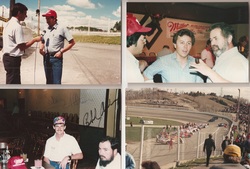
Many community members have some great memories of Slinger Nationals and the racers who have visited Slinger, WI. Dave and Cindy Retzlaff, like many community members, had a great time connecting with racers who had national reputations. Cindy submitted these photos. There are several more photos in the family section document above. As photos come in, the plan is to have a special section just for key photos.
In 1987 when these photos were taken, many community members would visit with racers to socialize at the Timber Inn (now M.J. Stevens). See story above on Blanchards to read about Terry Blanchard, who owned the TImber Inn.
Dale Earnhardt, Bobby Allison, and Alan Kulwicki (photo above). 1987. Submitted by Cindy Retzlaff
In 1987 when these photos were taken, many community members would visit with racers to socialize at the Timber Inn (now M.J. Stevens). See story above on Blanchards to read about Terry Blanchard, who owned the TImber Inn.
Dale Earnhardt, Bobby Allison, and Alan Kulwicki (photo above). 1987. Submitted by Cindy Retzlaff
Go-Kart
Whereas Miles Melius may have used midget racing in the late 1940s as a segway to modifieds, many of today's younger racers start with building and racing a Go-Kart.
Click here for the Memorial Go-Kart, Inc. website.
Click here for the sociological study of go-karts at Slinger Speedway by sociology student Angela Shomler. (2014)
Click here and here to read about Slinger student, Mike McAndrews, and his go-kart success (Sophomore 2013-2014).
Whereas Miles Melius may have used midget racing in the late 1940s as a segway to modifieds, many of today's younger racers start with building and racing a Go-Kart.
Click here for the Memorial Go-Kart, Inc. website.
Click here for the sociological study of go-karts at Slinger Speedway by sociology student Angela Shomler. (2014)
Click here and here to read about Slinger student, Mike McAndrews, and his go-kart success (Sophomore 2013-2014).
Photo Evidence of Racing Culture
Click here for the Photo Evidence of Racing Culture Study by Sociology student Amber Zawistowski (2014)
Click here for the Photo Evidence of Racing Culture Study by Sociology student Amber Zawistowski (2014)
Other Racing Culture Examples from the Slinger Area
-In addition to racing at Slinger, there are several Slinger area racers who have raced in motocross (examples coming soon). There are also some racers who race different types of vehicles that are not part of the Slinger Super Speedway.
-The Milwaukee Journal Sentinel featured local Slinger Super Speedway racers and their lifestyle, budget, on May 4th, 2018.
-In addition to racing at Slinger, there are several Slinger area racers who have raced in motocross (examples coming soon). There are also some racers who race different types of vehicles that are not part of the Slinger Super Speedway.
-The Milwaukee Journal Sentinel featured local Slinger Super Speedway racers and their lifestyle, budget, on May 4th, 2018.
Work Culture at the Slinger Super Speedway
"Whatever you do in life, try to do something you enjoy. It won't seem like a job. Be passionate about what you enjoy and chase that dream." Todd Thelen, owner and promoter, Interview with Slinger HS Sociology students, October 5, 2017.
From owners to public relations to office managers to ticket sellers to concession workers to fire fighters to announcers to flagmen to maintenance workers, there are many people working, often behind the scenes , during the week, or in the off-season, to make sure the race track operates smoothly come Sunday Night. We hope to add more about work at the Slinger Super Speedway in the future. Here is a starting point.
Story One: Race Track Paving work in 2014 by Wolf Paving (Source: Wolf Paving website)
Story Two: Race track chaplain Jim Zeirke story by Future Author's Camp participants (2017). To learn more about Jim, click here.
Story Three: Working Lives at the Slinger Super Speedway research (Fall 2017 research by sociology students featuring excerpts from ownership, marketing, maintenance workers, concession workers, Memorial Go-Kart promoter, and more.
Story Four: Student racer sociology paper about working on car. Sister of racer's story about behind-the-scenes aspect of racing.
More work stories will be added.
Video below was created by Dean Leisgang with interview help from Slinger HS sociology students and their teacher, Nate Grimm.
